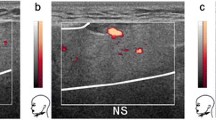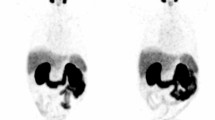Abstract
Purpose
A serious side effect of high-activity radioiodine therapy in the treatment of differentiated thyroid cancer is radiogenic salivary gland damage. This damage may be diminished by lemon-juice-induced saliva flow immediately after 131I administration. The aim of this study was to assess the effect of chewing lemon slices on the absorbed (radiation) doses to the salivary glands.
Methods
Ten patients received (pretherapy) 124I PET(/CT) dosimetry before their first radioiodine therapy. The patients underwent a series of six PET scans at 0.5, 1, 2, 4, 48 and ≥96 h and one PET/CT scan at 24 h after administration of 27 MBq 124I. Blood samples were also collected at about 2, 4, 24, 48, and 96 h. Contrary to the standard radioiodine therapy protocol, the patients were not stimulated with lemon juice. Specifically, the patients chewed no lemon slices during the pretherapy procedure and neither ate food nor drank fluids until after completion of the last PET scan on the first day. Organ absorbed doses per administered 131I activity (ODpAs) as well as gland and blood uptake curves were determined and compared with published data from a control patient group, i.e. stimulated per the standard radioiodine therapy protocol. The calculations for both groups used the same methodology.
Results
A within-group comparison showed that the mean ODpA for the submandibular glands was not significantly different from that for the parotid glands. An intergroup comparison showed that the mean ODpA in the nonstimulation group averaged over both gland types was reduced by 28% compared to the mean ODpA in the stimulation group (p=0.01). Within each gland type, the mean ODpA reductions in the nonstimulation group were statistically significant for the parotid glands (p=0.03) but not for the submandibular glands (p=0.23). The observed ODpAs were higher in the stimulation group because of increased initial gland uptake rather than group differences in blood kinetics.
Conclusion
The 124I PET(/CT) salivary gland dosimetry indicated that lemon juice stimulation shortly after 131I administration in radioiodine therapy increases the absorbed doses to the salivary glands.




Similar content being viewed by others
References
Hyer S, Kong A, Pratt B, Harmer C. Salivary gland toxicity after radioiodine therapy for thyroid cancer. Clin Oncol 2007;19:83–6.
Luster M, Clarke SE, Dietlein M, Lassmann M, Lind P, Oyen WJ, et al. Guidelines for radioiodine therapy of differentiated thyroid cancer. Eur J Nucl Med Mol Imaging 2008;35:1941–59.
Mandel SJ, Mandel L. Radioactive iodine and the salivary glands. Thyroid 2003;13:265–71.
Creutzig H. Sialadenitis following iodine-131 therapy for thyroid carcinoma: letter to the editor. J Nucl Med 1985;26:817.
Allweiss P, Braunstein GD, Katz A, Waxman A. Re: Sialadenitis following I-131 therapy for thyroid carcinoma: letter to the editor. J Nucl Med. 1985;26:817.
Van Nostrand D, Atkins F, Bandaru VV, Chennupati SP, Moreau S, Burman K, et al. Salivary gland protection with sialagogues: a case study. Thyroid 2009;19:1005–8.
American Thyroid Association (ATA) Guidelines Taskforce on Thyroid Nodules and Differentiated Thyroid Cancer; Cooper DS, Doherty GM, Haugen BR, Kloos RT, Lee SL, Mandel SJ, et al. Revised American Thyroid Association management guidelines for patients with thyroid nodules and differentiated thyroid cancer. Thyroid 2009;19:1167–214.
Nakada K, Ishibashi T, Takei T, Hirata K, Shinohara K, Katoh S, et al. Does lemon candy decrease salivary gland damage after radioiodine therapy for thyroid cancer? J Nucl Med 2005;46:261–6.
Jentzen W, Hobbs RF, Stahl A, Knust J, Sgouros G, Bockisch A. Pre-therapeutic 124I PET(/CT) dosimetry confirms low average absorbed doses per administered (131)I activity to the salivary glands in radioiodine therapy of differentiated thyroid cancer. Eur J Nucl Med Mol Imaging 2010;37:884–95.
Freudenberg LS, Antoch G, Jentzen W, Pink R, Knust J, Görges R, et al. Value of 124I-PET/CT in staging of patients with differentiated thyroid cancer. Eur Radiol 2004;14:2092–8.
Jentzen W, Weise R, Kupterschlager J, Freudenberg l, Brandau W, Bares R, et al. Iodine-124 PET dosimetry in differentiated thyroid cancer: recovery coefficient in 2D and 3D modes for PET(/CT) systems. Eur J Nucl Med Mol Imaging 2008;35:611–23.
Jentzen W. Experimental investigation of factors affecting the absolute recovery coefficients in iodine-124 PET lesion imaging. Phys Med Biol. 2010;55:2365–98.
Acknowledgments
The authors are indebted to Dr. Robert F. Hobbs (Johns Hopkins University, School of Medicine, Baltimore, MD, USA) for critically reviewing the manuscript and for improving its readability.
Conflicts of interest
None.
Author information
Authors and Affiliations
Corresponding author
Rights and permissions
About this article
Cite this article
Jentzen, W., Balschuweit, D., Schmitz, J. et al. The influence of saliva flow stimulation on the absorbed radiation dose to the salivary glands during radioiodine therapy of thyroid cancer using 124I PET(/CT) imaging. Eur J Nucl Med Mol Imaging 37, 2298–2306 (2010). https://doi.org/10.1007/s00259-010-1532-z
Received:
Accepted:
Published:
Issue Date:
DOI: https://doi.org/10.1007/s00259-010-1532-z




